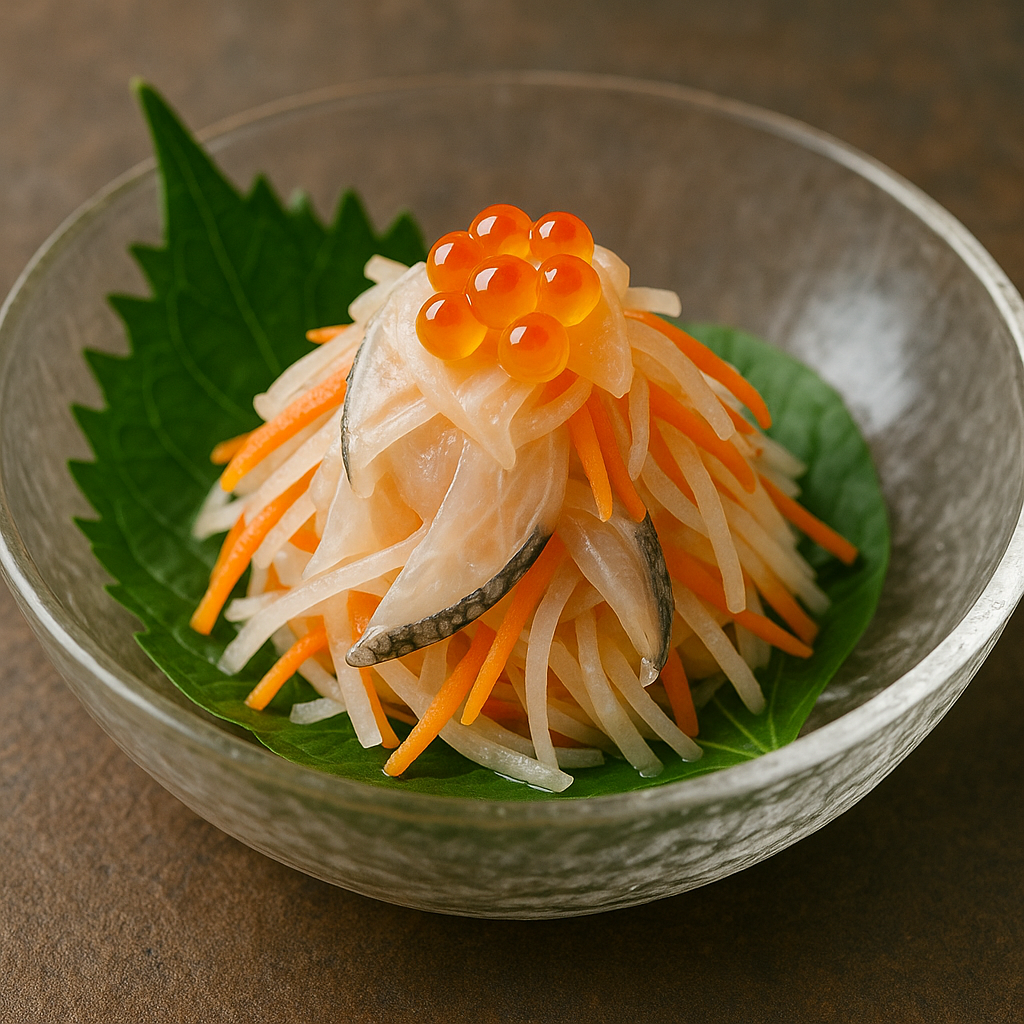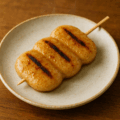氷頭なますの特徴
鮭の鼻軟骨“氷頭”を薄切りにし、酢でさっぱりと
氷頭なますは、鮭の頭先端にある透明な鼻軟骨(氷頭)を薄く切り、大根やにんじんとともに甘酢で和える郷土料理です。こりっとした独特の食感と、ゆずや昆布の香りが爽やかに広がります。
北東北・北海道に伝わる冬のごちそう
鮭の食文化が根づく地域で親しまれてきた一品で、紅白の色合いが晴れやかで、正月料理にもよく並びます。下処理を丁寧にすると、澄んだ味わいに仕上がります。
氷頭なます レシピ
材料(5人分)
- 鮭の氷頭(鼻軟骨) 150〜200g(薄切り)
- 大根 300g(細切り)
- にんじん 50g(細切り)
- 昆布 5cm(細切り)
- ゆずの皮 少量(細切り)
- 酢 120ml
- 砂糖 大さじ2〜3
- うす口しょうゆ 小さじ1(風味付け・任意)
作り方
- 1. 氷頭を薄切りにし、塩小さじ1で軽くもむ。熱湯に10〜20秒くぐらせ、氷水に取り、水気をしっかり切る。
- 2. 大根・にんじんは塩少々で軽くもみ、10分置いて水気を絞る。
- 3. 合わせ酢を作る:酢・砂糖・塩少々・うす口しょうゆを混ぜ、昆布・ゆず皮を加える。
- 4. 氷頭と野菜を合わせ酢で和える。冷蔵で30分〜一晩なじませる。
- 5. 味を見て、酢・砂糖・塩で微調整する。
シェフのワンポイントアドバイス
- 氷頭は1〜2mmの薄切りが食べやすいです。湯通しは短くして食感を保ちます。
- 昆布は細切りで直接加えると旨みが出ます。塩昆布で代用してもまとまりやすいですね。
- 一晩置くと味が馴染みます。直前にゆず皮を少量足すと風味が向上します。
栄養価(1人分の目安)
- エネルギー:70〜120 kcal
- たんぱく質:6〜10 g(氷頭由来)
- 脂質:1〜3 g
- 炭水化物:6〜12 g(調味の砂糖量で変動)
- ミネラル・コラーゲン:氷頭・昆布・野菜由来
歴史
“氷頭”の名は透明な軟骨に由来します
鮭の鼻軟骨は氷のように透き通る見た目と心地よい歯ざわりが特徴で、希少部位として大切に食されてきました。薄切りにして酢で引き締める調理が定着しました。
正月の紅白なますとして定着しました
大根(白)とにんじん(紅)の取り合わせに縁起を重ね、鮭文化の地域で正月料理の一品として受け継がれてきました。家ごとの甘酢配合や香り付けの工夫が今も伝わっています。
English Version
Features of Hizu Namasu
Thin-sliced salmon nasal cartilage, bright and tangy
Hizu namasu is a regional dish of thinly sliced salmon nasal cartilage (“hizu”) dressed with sweet vinegar and mixed with daikon and carrot. It offers a crisp, crunchy bite with refreshing notes of yuzu and kombu.
A winter delicacy of North Tohoku and Hokkaido
Rooted in salmon-eating regions, its festive red-and-white colors suit New Year platters. Careful prep yields a clean, clear flavor.
Hizu Namasu – Recipe
Ingredients (Serves 5)
- Salmon nasal cartilage (hizu) 150–200 g, thin-sliced
- Daikon 300 g, thin matchsticks
- Carrot 50 g, thin matchsticks
- Kombu 5 cm, fine strips
- Yuzu peel, a little, fine strips
- Vinegar 120 ml
- Sugar 2–3 Tbsp
- Light soy sauce (usukuchi) 1 tsp (optional)
- Salt 1 tsp + a pinch (for pretreatment and seasoning)
Directions
- 1. Salt the sliced hizu with 1 tsp salt; blanch 10–20 seconds, shock in ice water, and drain very well.
- 2. Lightly salt the daikon and carrot (pinch of salt), rest 10 minutes, then squeeze out moisture.
- 3. Make the dressing: combine vinegar, sugar, a pinch of salt, and light soy; add kombu and yuzu peel.
- 4. Toss hizu and vegetables with the dressing; chill 30 minutes to overnight.
- 5. Taste and adjust with vinegar, sugar, or salt.
Chef’s Tips
- Slice hizu to 1–2 mm for the best bite; keep blanching brief to retain texture.
- Adding kombu as fine strips boosts umami; salted kombu also works.
- Resting overnight deepens flavor; add a fresh pinch of yuzu peel before serving.
Nutrition (per serving, approx.)
- Energy: 70–120 kcal
- Protein: 6–10 g
- Fat: 1–3 g
- Carbohydrates: 6–12 g
- Minerals & collagen from hizu, kombu, and vegetables
History
Name from icy translucence
The nasal cartilage is prized for its clear, ice-like appearance and crisp texture. Thin slicing and vinegar dressing became the standard preparation.
Red-and-white namasu for New Year
The pairing of white daikon and red-orange carrot evokes auspicious colors, and the dish has long been served on New Year tables in salmon regions, with household variations in sweetness and aroma.



何でも質問してください!